|
|
  

WT Archives - 2017/8/31
Greening government - ESAP
WALKING THE TALK
Feds, p3 reno of entire Ottawa area heating/cooling system will spew way less GHG
Background
At the heart of the greening of the National Capital Energy Systems is a plan to
transition Public Services and Procurement Canada (PSPC)'s properties to 100-per-cent clean power. This includes updating five central heating and cooling plants at Confederation Heights, Tunney's Pasture, the Cliff plant at 1 Fleet St., the National Research Council at 98 Sussex Dr., and the Canadian Government Printing Bureau at 45 Sacré-Coeur Blvd. in Gatineau. To accomplish this project, the Canadian government has opted to set up a public/private partnership or P3.
The objective of this second interview with Thomasz Smetny-Sowa, Senior Director, Real Property Branch, Public Services and Procurement Canada, is to clarify the terms of this P3 agreement and explore the different zero-emission alternative enrgy sources that the federal government is looking into.
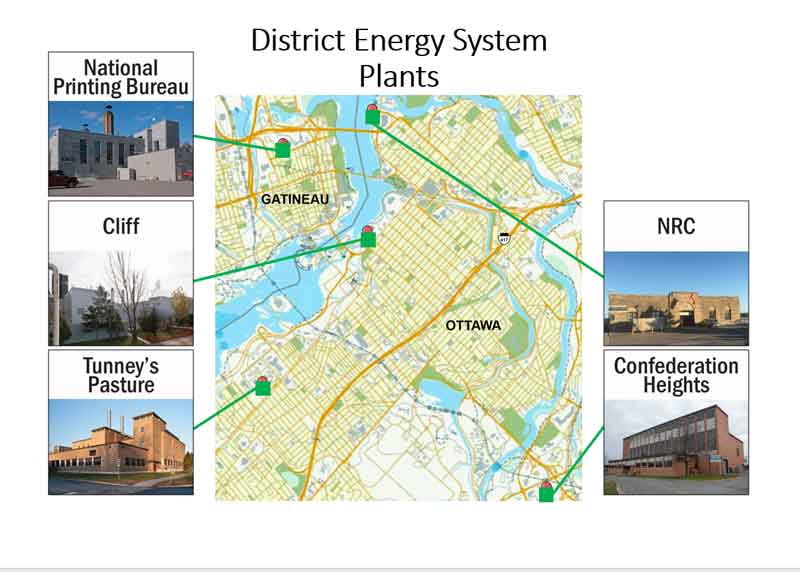
Q&A
WaterToday - This is an interview about the P3 arrangement Canadian government has set up for the modernization of the National Capital Energy Systems. So, right out of the gate, my understanding of the P3 arrangement is that PSPC will build not only the plants but the piping to the 80 buildings. Is this correct? Can you walk us through what private sector partner will be responsible for?
Smetny-Sowa - No, that is not correct. In this case, the P3 project is a Design Build Finance Maintain and Operate model. In short, it's a DBF type of contract. It means that we sign the contract with the private sector proponent to design, build, finance, maintain and operate our generation and distribution assets.
What this means is that the private sector partner will take our existing plants; the building and what's inside – boilers, chillers, distribution parts and everything - and will convert them from steam to low-temperature hot water and provide a new efficient infrastructure.
If they must upgrade the buildings, they will do so based on the requirement that the asset must be in the same state, as well as operational for 5 more years, after the contract ends in in 35 years.
So for argument's sake, if they look at the Tunneys Pasture plant, they won't replace the building. They may replace a window, do some paint job but they will maintain the building.
In the case of the Cliff Building, they'll have to take down the temporary boiler plant - this is the one installed on a parking lot beside the Supreme Court - and completely rebuild the plant that is by the river. |

Cliff Plant-Outside Wall Photo:PSPC
|
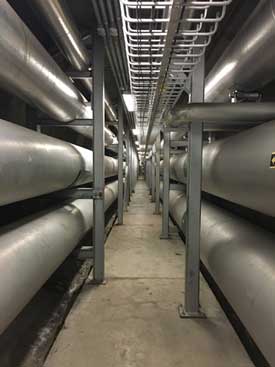
Cliff Plant - Tunnels Photo:PSPC
|
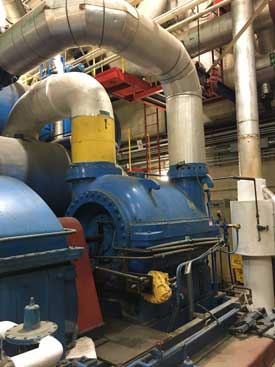
Cliff Plant - Steam Chiller Photo:PSPC
|
They will also have to replace all the piping that goes between the buildings and the plants. Sorry. I take it back. They don't have to replace the pipe. They have to guarantee that the pipe will be in good operational state 5 years past the contract.
They will also be responsible for all the breakage in the pipes. So this is where they will have to make a business decision as to whether the pipes are so old, and some of them are, that the risk is too high so they will take this pipe out and put a new pipe in.
If they say okay, for example cooling was installed in the 50s and the pipe lifespan is about 100 years. So they'll probably last until 2055, giving them an additional 5 years at the end of the contract. So, they might take a risk and leave the pipe in. and they'll say, "Okay; we're good enough with the cooling piping."
WaterToday - Okay. Just for clarity sake when you say 'they' that's a separate private company.
Smetny-Sowa - Correct the consortium that wins the bet. This is the P3 partner that we're talking about; the private sector partner.
WaterToday - Okay. So lets say I'm a private consortium; I bid for this, I get the contract. I do all of this work and guarantee it for 35 years. Does the federal government pay like once a month to do all of this work for a 35 year period?
Smetny-Sowa - It's slightly different in this case. Because we have a short-term finance. So we will pay them 75% of the capital construction cost that they invested in our assets at the substantial completion; for argument sake five years after they sign the contract, because we give them 5 years to convert the entire infrastructure. We hold back 25% of the capital construction cost for the next two years to make sure that they install equipment that operates properly and operates to our satisfaction.
And we pay them the remaining 25% in the year 7 after the contract. That means there's no money at risk at all.
WaterToday - There's no public money at risk, no private money at risk.
Smetny-Sowa - That's correct. So for the next 30 years we're paying them a maintenance and operational fixed cost plus variable fuel cost. Because nobody will bet on a fuel for next 35 years. It's just impossible to predict.
And if they do, the premium would be super high. So the fuel is passed-through. So whether they spend money on natural gas, electricity and water, we pay the bill. And we charge the building that are being fed with the thermal energy.
We also pay standard maintenance and operation fee because they'll have the staff, they'll have to replace some of the chemicals and some of the equipment will have to be replaced since, in some cases, the life cycle is less than 30 years. this is all fixed cost. The only flexible cost is consumption of the fuel.
WaterToday - One of the things that does not seem obvious to me relates to the carbon credits. In another article, you talk about the enormous tonnage of carbon gases being taken out of the atmosphere with this project.
For instance you have said at one point that 44,000 metric tons would be saved, I believe it's per year, so I did a little bit of research on this. And if I'm selling or buying a carbon credit at $18, I think that's the rate right now, if I take the 44,000, multiply it by the 18 per ton that's a sizable amount of money. How do carbon credits work in this situation? Because you're talking about such a massive undertaking. And these numbers are in the hundreds of thousands of metric tons. Can you tell me a little bit about how that would work?
Smetny-Sowa - Okay. So, to start with, we will have a new base line once we convert the system. What you're talking about are the savings tied to the steam operation. Right. So that doesn't apply anymore because we will have a new base line. And whatever they'll be saving over and above, that's where your carbon credit - it's actually not a carbon tax, its carbon trade in Ontario - might come into the play. So they'll be much less than what you mentioned.
We're still not sure if federal government will capitalize on a carbon tax or carbon trade, or just save GHG without selling the credit. That's a policy change. And, at the present time, the government is not capitalizing on GHG savings.
WaterToday - Okay. So the consortium can do what they want with those, is that's the case then?
Smetny-Sowa - No. they won't get it. They won't get the credit at the present time.
What I mean is that the assets are still ours, the consortium is only operating a public works asset and the credit goes to the owner of the facility not to the operator. In this case, the federal government. But so far the federal government has not made the decision as to whether they will sell the credit or just save the GHG.
WaterToday - Okay, I understand that. Thanks for the clarification. So moving on then. I'm trying to understand the timeline; you said 5, 7-year terms and then there's the 35 years. I'm not 100% sure.
Smetny-Sowa - For argument sake, we plan to sign the contract in let's say May June of 2019.
The consortium then will have several months to go over our operation and build up their team, we call this the transition period. So by April 1st 2020, they walk into the plant. We walk out of the plant. They take over.
From there, they have 5 years to 2025 to convert the entire infrastructure, and assuming they did the job we pay them 75% of capital construction cost, the cost they spent on changing the infrastructure, plant and distribution.
WaterToday - Okay.
Smetny-Sowa - But you realize that this operation is a transition and we cannot really measure the efficiency of the operations because they operate half of the old, half of the new. So this is like a conversion period. So another two years is added. So by 2025 April 1st, the new regime kicks in. And they must meet key performance indicators - GHG saving, energy saving, relative to safety and all kinds of requirement that we'll put in the RFP (Request for Proposal) that they have to achieve in order to get paid.
So for the next two years we're watching how they operate closely. And if they reach all the key performance indicators, making sure that boilers and chillers and distribution pipings perform to our satisfaction, we pay them the remaining 25% of the capital construction cost.
And that's it. There's no more capital cost into this project for the next 30 years of operation. Because five years already passed. Actually 28 years of operation to be honest. Because 5 years, then you got 2 years and 28 years makes 35 years of operation. And that's when the contract ends.
But from the day one to the last day of 35 years operation we're paying the maintenance and operation and fuel cost. Which is independent of capital estimate.
So the capital repayment is the financing cost that they incur to borrow from the bank to be able to upgrade the plants during the 5 years transition period; 75% goes back to the lenders after five years and the next 25% goes to the lenders in the last two years.
WaterToday - I get it. I actually understand that and my viewers will too. So thanks for the clarification.
One of the things we talked about in our previous interview was the "tiny" experiments in biomass that you are conducting and from what I've read you have high hopes that this will sort of escalate to become much more important in the future scenario. Or am I reading this wrong?
Smetny-Sowa - No. You are absolutely correct. Currently the plan is based on GHG reduction achieved through technological change, not fuel change. For the moment, the fuel remains natural gas.
So we're still burning everything GHG. And in order to get away from this, we have to switch the fuel to something different.
We did a lot of studies and it looks like biomass is the way to go. But as we have several different types of biomass, - we're testing two of them currently - but we're positive that at least one of them will be a future fuel for ESAP. Starting from let's say 6 months from now, we will finish our study on large scale biomass. And if the government is onside to go ahead with it, we will consider another P3 contract. But in this case, it will be a different type of P3 agreement; we call it a power purchase agreement.
In essence, we will seek to set up a power purchase agreement with a private sector proponent to provide us with thermal energy which is 100% generated from biomass which will eliminate almost 100% of the GHG in the heating systems.
At this stage it's not really financially viable to do everything but we can go 90% of the way. The remaining 10% is very, very expensive to get rid of so we will have still be using gas for this 10% but the remaining plan is to switch from natural gas to biomass.
WaterToday - Everyone I've talked to in the renewable sector is fairly optimistic that next year, or just around the corner there's going to be some kind of super energy - really, really good solar; really, really good wind; super-duper biomass. Can you tell me a little bit about your views on the renewable sector technologies that you know of so far?
Smetny-Sowa - There's no doubt that the renewable energy sector is growing. But the cost of it varies tremendously. And it depends on the market that you have, the country, the location and availability, the cost of energy and government incentives.
Take Europe for example, the cost of total energy there is three times higher than in Canada. So all the renewable energy sources are relatively cheaper than in Canada. Let's take a look at Denmark. They have no forest and they have to import all their fuel but they've got a lot of wind. So in their case it might be economically viable to build the windmills.
Windmills and solar are very good sources of energy. However the problem with me is that they're intermittent, and so far it's very difficult to store it . In our case the amount of solar and wind in Ontario is small for a time being and it's mainly used for electricity production or heating.
And to me the use of the highest grade of energy for heating is just wrong. Because you can do so much more with electricity than burning cannot do. You can drive your computers. You can drive the dialysis machine. You can power the hospital. You cannot do that with burning fuel right. So to me the wrong use if you use electricity for heating.
WaterToday - Just before I let you go, you talk about bringing in other partners over the course of this; did you mean for instance like a hospital or the city of Ottawa itself?
Smetny-Sowa - We did a heat density map for Ottawa in collaboration with city of Ottawa. And their renewable strategy to get carbon neutral or zero carbon relies heavily on carbon free fuel.
So we talked with the Rendez-vous project developers in Lebreton Flats, we talked with the City of Gatineau, we talked with the city of Ottawa and they're all very interested to connect to the system if we create carbon neutral fuel.
WaterToday - That's just amazing! I don't talk to many people who talk about putting an entire city on their system. How realistic is that just before I let you go?
|
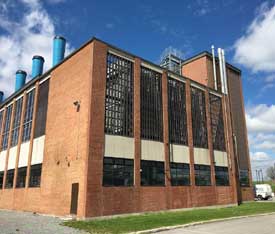
Confederation Plant-Outside Wall Photo:PSPC
|
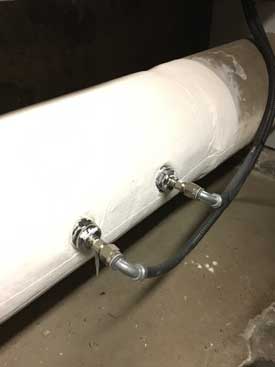
Confederation Plant-Smart Building Upgrade Photo:PSPC
|
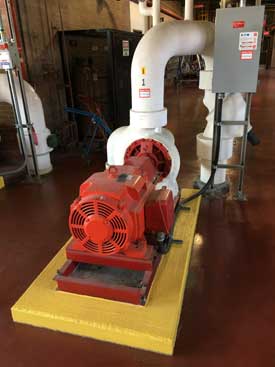
Confederation Plant-Pump Photo:PSPC
|
Smetny-Sowa - It is realistic but it has to be financially viable. So we looked at the entire district. Our plan is to bring the pipe from Ottawa over Chaudière Island and go across all the way to Gatineau tying into Terrasse Chaudière, Place du Portage, and City Hall; and maybe the provincial court. So, the entire district along the south shore of Gatineau will be connected to the system. And the city of Gatineau is very, very excited about it. When we move the pipe over to Tunneys Pasture, we also cross the Rendez-vous Lebreton Flats development. And they're very interested in putting their building on district heating system; both heating and cooling.
And there's talk about hooking up the new Ottawa hospital. Unfortunately, this is not the ideal location because we're pretty far away between our two plants Confederation Heights and Cliff; it's a few kilometres away and there's not much on the way except for residential. And you know when you hook up a building somebody has to pay for a pipe, right?
WaterToday - That's right.
Smetny-Sowa - The private sector development won't add money to the project, they want to make money, so we will have to tie the building being connected, which means that the cost of energy might be higher than natural gas. And that's a no-no. Like nobody will connect the building if it cost a dollar more than natural gas. They all talk about being green, it's just talk. You know.
WaterToday - I see that.
Smetny-Sowa - Unless it's cheaper nobody will buy. You have to make it feasible. So we are looking for high density where we can connect several buildings and divide the cost of the infrastructure such that everybody is still below natural gas. As you know, natural gas is super cheap now, it's very, very hot.
|
|
|
|
|
Have a question? Give us a call 613-501-0175
All rights reserved 2025 - WATERTODAY - This material may not be reproduced in whole or in part and may not be distributed,
publicly performed, proxy cached or otherwise used, except with express permission.
|
| |